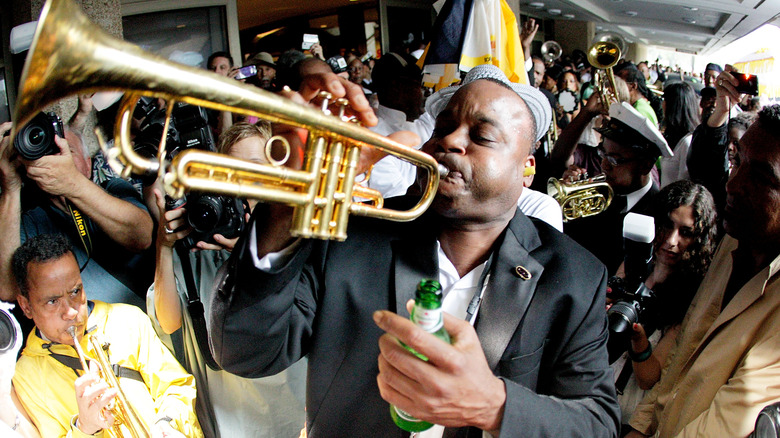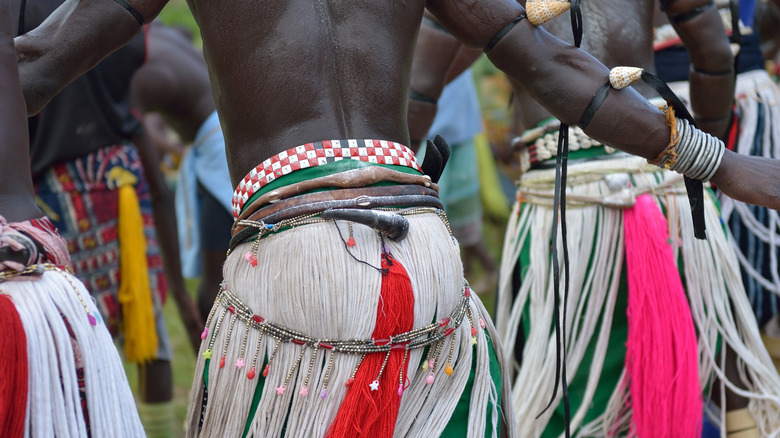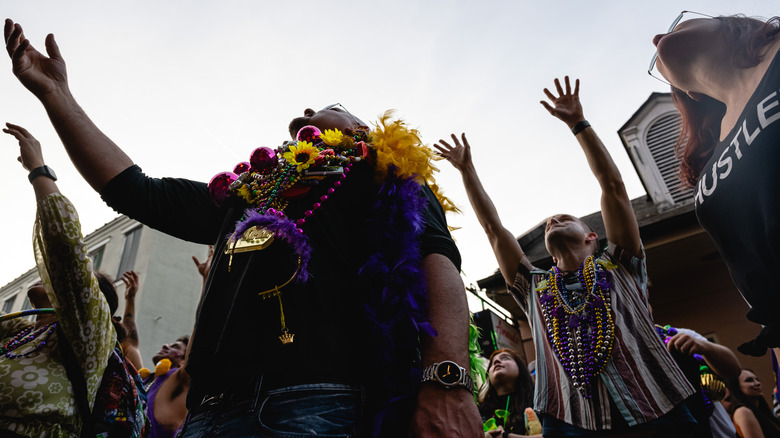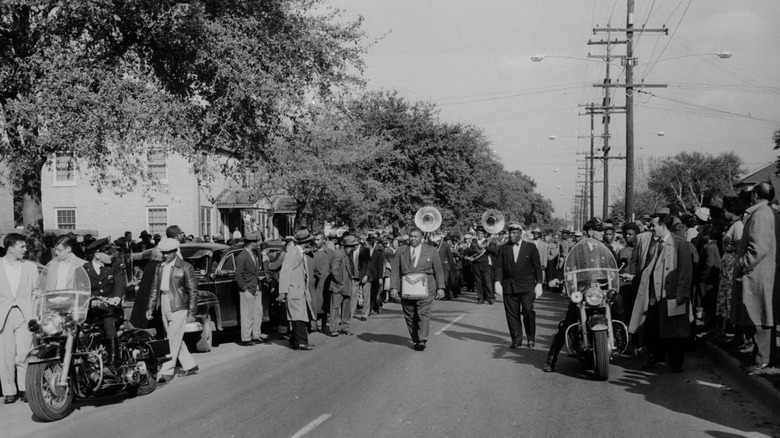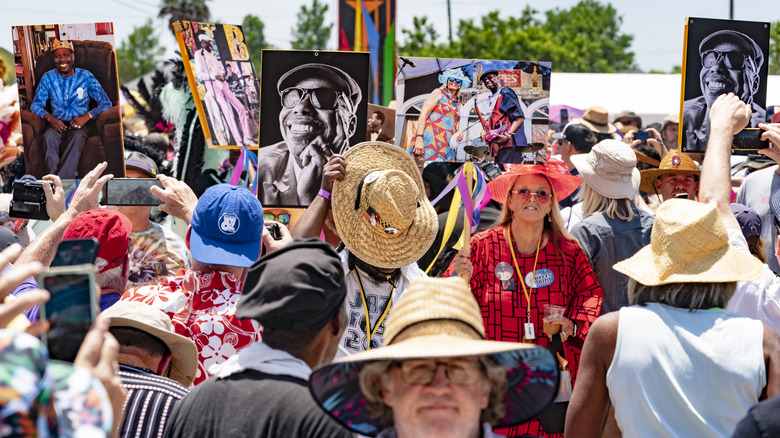Inside The Festive Jazz Funerals Of New Orleans
When thinking of a funeral, many people might imagine a congregation of black-dressed folks staring at the ground while sad — perhaps with rain pattering on umbrellas for full, somber effect. But while sorrow itself is a natural response to the loss of life, funerals the world over often take on special flavors depending on culture, history, region, and so forth, some more lively or unusual than others. "Fantasy coffins" are all the rage in Ghana, shaped like lions, rockets, sneakers, Coke bottles, airplanes, you name it. Varanasi, India burns 24-7 funeral pyres to incinerate the dead before tossing their ashes into the Ganges river. Taiwan, meanwhile, has mafia-linked funeral strippers who dance and gyrate above coffins. And in New Orleans? It's all about exuberance, joie de vivre, and music perfectly befitting them both: jazz.
In a way, nothing could suit New Orleans more than jazz funerals. A fusion of West African, British, Spanish, and French influences combined with Mardi Gras, Black Southern Protestantism, and the spirituals of enslaved Americans, jazz funerals are just as sui generis — a thing of its own — as New Orleans itself. As sites like Vox highlight, jazz funerals mourn the dead, but they also celebrate life and the hope of life after death for the one who's passed away. Imagine a big, community brass band parade marching through the streets and you've got a good idea of what jazz funerals are like.
From the old world to the new
All sources point to New Orleans' jazz funerals originating with indigenous, festive dance-and-music funeral processions in West African countries like Senegal and Gambia, as Vox explains. The Balch Institute for Ethnic Studies explains that ethnic groups like the Yoruba and Dahomean in the current-day nations of Benin and Togo have similar practices. Such practices revolve around celebrating the soul's entry into the afterlife and connect to beliefs in the spirit world and a hierarchical cosmic order of God-spirit-human. This is why West African spiritual beliefs — when they arrived in the New World — ironically found a fitting home within predominantly Christian Americas.
Aeon, meanwhile, also cites cultural back-and-forth between New Orleans and nearby Caribbean nations like Haiti as helping give rise to jazz funerals. Notably, Haitian Vodou (also spelled "Voodoo") retains celebratory practices meant to appease spirits. And of course, as French Quarter says, New Orleans has always been a hotspot for Louisiana Vodou for the same reason it spawned jazz funerals: slavery. From about 1480 C.E. to 1888 C.E., the Transatlantic Slave Trade took enslaved peoples from various African tribes to the Americas. Some of these individuals wound up in New Orleans, founded in 1718 by French-Canadian explorer Jean-Baptiste Le Moyne, Sieur de Bienville. From that point, New Orleans' syncretic culture brewed.
Brass band, Mardi Gras, and spirituals
New Orleans' founding as a French city added another critical piece to the jazz funeral puzzle: Mardi Gras, the French incarnation of the Catholic Lenten holiday of Shrove Tuesday, aka Fat Tuesday, the day before Ash Wednesday. As Father William Saunders says on Catholic Culture, Shrove Tuesday was the Catholic liturgical calendar's "last chance for merriment" before showing restraint during Lent. Traditions date back to ancient Rome, connect to pagan holidays like Saturnalia, were documented by the Anglo-Saxon clergyman Abbot Aelfric in 1,000 C.E., and by the time we get to the founding of New Orleans in 1718 involved celebratory processions and parades down the street, as Mardi Gras New Orleans describes.
New Orleans, meanwhile, was passed to Spain in 1763. It soaked up Spanish culture for 40 years before the U.S. bought it as part of the Louisiana Purchase in 1803. Per Metro, it was common for military brass bands to play funerals during this entire time. Such bands played the same instruments wielded in jazz come the late 1890s, when BBC says the musical form evolved into its familiar, syncopated, up-tempo form. But the roots of jazz, much like jazz funerals, dated back to 1819, shortly after Louisiana became a state in 1812. Per the BBC, enslaved Americans congregated in New Orleans' Congo Square on free days, where African tribal dances and rhythms fused with colonial influences, brass band instruments, and one final component: Christian spirituals.
When the Saints Go Jazzing On
As 64 Parishes says, the first recorded version of a jazz funeral was witnessed by architect Benjamin Latrobe in 1819. West African influences were plain and apparent from the get-go, as those enslaved people engaged in "ring shouts," a kind of call-and-response rhythmic dance circle that spins counterclockwise. Funeralwise says that the Catholic church wasn't too keen on these kinds of gatherings — ironically so, given jazz funeral's processional, celebratory connection to Mardi Gras. Nevertheless, it fell to Southern Protestant Blacks to engage in "public performances to consolidate a sense of community," as J. David Maxson writes in Southern Quarterly.
On that note, Visit New Orleans says that jazz funerals typically incorporated the old folk spirituals that passed around the U.S.' Protestant South, like "Nearer my God to Thee" and "When the Saints Go Marching In." These spirituals strengthened community and united ancient traditions with present beliefs in a hopeful way. Even modern-day jazz funeral bands like the famed Dirty Dozen Brass Band still focus on spirituals, as their 2004 album "Funeral for a Friend" shows. Song titles include classic spiritual adaptations like "Just a Closer Walk with Thee," "What a Friend We Have in Jesus," "Down by the Riverside," "Amazing Grace," "John the Revelator," and more.
Joining the Second Line
After jazz funerals fused with late 19th-century, recognizably modern jazz, they marched unabated into the 20th century. Jazz swept the U.S. in the 1920s following the end of World War I but petered off in popularity in the 1930s because Americans started struggling for disposable income. But come the mid-20th century jazz funerals started becoming more widespread, in part because funerals themselves became more affordable. This was especially the case for well-known New Orleans locals — such as jazz musicians — who were honored with jazzy outros befitting their lives.
It was during this time that jazz funerals took on a standardized structure. Musicians played sad, somber, hymn-like tunes on the way to a cemetery, where a memorial service took place, and then played lively, celebratory music on the way back. This "second line," as it was called, is the typically bouncy and exuberant part of the jazz funeral that gives it its signature flair, as seen above. Locals could join the procession on the way to the cemetery — provided they were respectful — but more than likely folks joined during the celebratory second half of the funeral. As Ausettua Amor Amenkum of New Orleans' Tulane University recalls on Vox, "I come from the era when you're in your house and you hear music and you go 'Second line!' and you run outside."
Modern homecoming ceremonies
Jazz funerals exist to this day and have taken to incorporating other elements of Black American culture, like funk, hip-hop, and rap. Currently, jazz funerals are held not just for jazz musicians or prominent New Orleans personages but also for young people or other members of the local community who died suddenly or tragically. Interestingly, Alive Network says that the 1973 James Bond movie "Live and Let Die" played a significant role in letting the wider world know about jazz funerals. That's also when the term "jazz funeral" took root. Nowadays, jazz funerals can be found around the U.S. and the entire globe. In 2015, for instance, Memphis hosted a jazz funeral for blues legend B.B. King.
The biggest and most prominent jazz funeral likely happened on August 29, 2006, in the wake of 2005's Hurricane Katrina. In case readers need reminding, Katrina and its flooding devastated low-lying New Orleans and killed a total of 1,833 people across Louisiana, Mississippi, and Alabama. Funeralwise says that thousands attended the jazz funeral conducted in honor of Katrina's dead in downtown New Orleans, where residents had stood stranded the year prior.
While not everyone gets a jazz funeral, those interested can hire musicians for the task via agencies like Alive Network, including travel to cities besides New Orleans. And yet, on Vox musician Stafford Agee says, "I never liked considering a funeral being a gig. I'm performing for somebody's homegoing ceremony."
